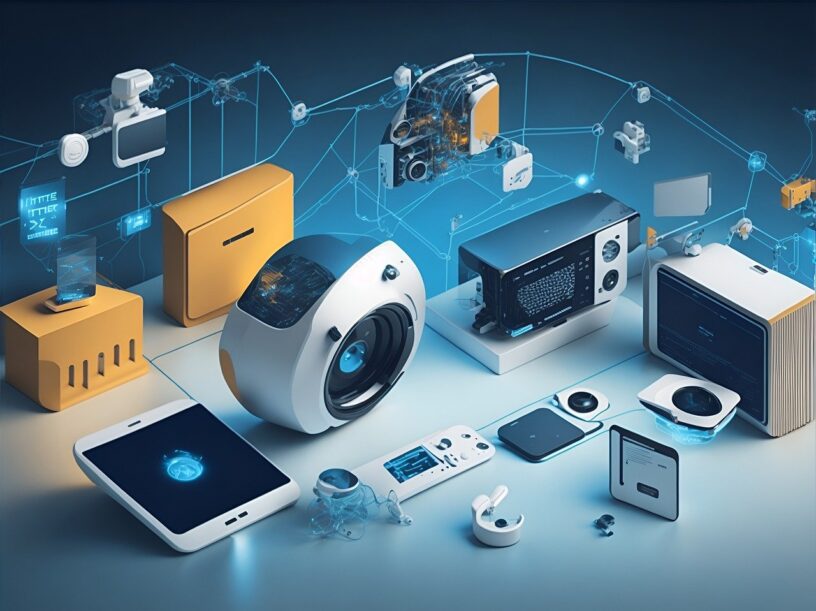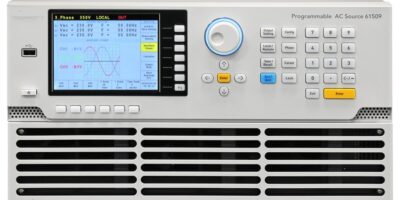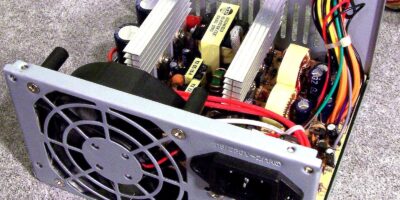The global IoT devices market size will increase from USD 1,853.46 million in 2023 to USD 4,851.28 million in 2033, with a CAGR of 10.10% during 2024-2033
Definition of IoT Devices
IoT (Internet of Things) devices are physical objects embedded with sensors, software, and other technologies that connect and exchange data with other devices and systems over the internet. These devices collect data from their surroundings, process it, and communicate with other IoT systems or networks, enabling automated responses, monitoring, and control.
How IoT Devices Work
- Sensors and Actuators:
- Sensors collect data from the environment, such as temperature, humidity, motion, light, or sound.
- Actuators perform actions based on commands received from the IoT system, like adjusting the temperature or turning on lights.
- Connectivity:
- Devices communicate with each other and with central systems via various networking protocols (Wi-Fi, Bluetooth, Zigbee, etc.). Connectivity can be direct or through gateways.
- Data Processing:
- The collected data is transmitted to cloud servers or edge devices for analysis. This data can be used to generate insights, trigger responses, or monitor conditions in real-time.
- User Interfaces:
- Users can interact with IoT devices through applications on smartphones, tablets, or computers, often receiving notifications or controlling devices remotely.
- Automation and Control:
- Based on predefined rules or machine learning algorithms, IoT systems can automatically take actions, such as adjusting settings or alerting users to specific conditions.
Key Products in the IoT Market
- Smart Home Devices:
- Smart Thermostats (e.g., Nest, Ecobee): Adjust temperature settings based on user preferences and habits.
- Smart Locks (e.g., August, Yale): Allow remote locking/unlocking and monitoring of door access.
- Smart Lighting (e.g., Philips Hue, LIFX): Enable control over lighting conditions via apps or voice assistants.
- Smart Appliances (e.g., Samsung Family Hub, LG ThinQ): Include connected refrigerators, ovens, and washing machines with remote control and monitoring features.
- Wearable Devices:
- Smartwatches (e.g., Apple Watch, Fitbit): Track fitness metrics, provide notifications, and support health monitoring.
- Health Monitors (e.g., Withings, Oura Ring): Measure vital signs like heart rate, sleep patterns, and activity levels.
- Industrial IoT (IIoT):
- Sensors (e.g., Bosch, Honeywell): Monitor machinery, environmental conditions, and processes in manufacturing.
- Predictive Maintenance Tools (e.g., IBM Watson IoT): Use data to predict equipment failures and schedule maintenance.
- Connected Vehicles:
- Telematics Systems (e.g., OnStar, Verizon Connect): Offer navigation, vehicle diagnostics, and fleet management.
- Autonomous Vehicles (e.g., Tesla, Waymo): Use sensors and AI to drive and navigate without human intervention.
- Healthcare IoT:
- Remote Patient Monitoring (e.g., BioTelemetry, Medtronic): Track health metrics and provide data to healthcare providers.
- Smart Medical Devices (e.g., insulin pumps, smart inhalers): Deliver personalized treatment based on real-time data.
- Smart Cities:
- Smart Traffic Lights (e.g., Siemens, Cisco): Optimize traffic flow based on real-time conditions.
- Environmental Sensors (e.g., BreezoMeter, Smart Sensors): Monitor air quality, noise levels, and other environmental factors.
Market Trends
- Growing Adoption in Various Sectors:
- Healthcare: Increasing use of remote monitoring and telemedicine.
- Manufacturing: Enhanced efficiency through predictive maintenance and automation.
- Retail: Improved inventory management and personalized customer experiences.
- Advancements in Connectivity Technologies:
- Emergence of 5G: Faster data transmission and lower latency enhance IoT performance.
- Development of Low-Power Wide-Area Networks (LPWAN): Supports long-range connectivity with minimal power consumption.
- Enhanced Security and Privacy Measures:
- Growing focus on safeguarding data and ensuring secure communication between IoT devices.
- Integration with AI and Machine Learning:
- Increasing use of AI for data analysis, enabling smarter decision-making and predictive capabilities.
- Expansion of Edge Computing:
- Reducing latency and improving processing efficiency by bringing computation closer to IoT devices.
Challenges
- Security and Privacy Concerns:
- Protecting devices from hacking and ensuring data privacy.
- Interoperability Issues:
- Ensuring compatibility and communication between different IoT devices and platforms.
- Data Management:
- Handling and analyzing large volumes of data generated by IoT devices.
- Standardization:
- Lack of universal standards can complicate integration and scalability.
Receive the FREE Sample Report of IoT Devices Market Research Insights @ https://stringentdatalytics.com/sample-request/iot-devices-market/13084/
Market Segmentations:
Global IoT Devices Market: By Company
• Cisco
• GE
• Honeywell
• Intel
• IBM
• ABB
• Rockwell Automation
• Siemens
• Huawei
• Bosch
• Kuka
• Texas Instrumemts
• Dassault Systemes
• PTC
• ARM
• NEC
Global IoT Devices Market: By Type
• RFID
• Industrial Robotics
• Distributed Control System
• Condition Monitoring
• Smart Meter
• Smart Beacon
• Yield Monitoring
• Electronic Shelf Label
• Others
Global IoT Devices Market: By Application
• Residential
• Commercial
• Industrial
Regional Analysis of Global IoT Devices Market
All the regional segmentation has been studied based on recent and future trends, and the market is forecasted throughout the prediction period. The countries covered in the regional analysis of the Global IoT Devices market report are U.S., Canada, and Mexico in North America, Germany, France, U.K., Russia, Italy, Spain, Turkey, Netherlands, Switzerland, Belgium, and Rest of Europe in Europe, Singapore, Malaysia, Australia, Thailand, Indonesia, Philippines, China, Japan, India, South Korea, Rest of Asia-Pacific (APAC) in the Asia-Pacific (APAC), Saudi Arabia, U.A.E, South Africa, Egypt, Israel, Rest of Middle East and Africa (MEA) as a part of Middle East and Africa (MEA), and Argentina, Brazil, and Rest of South America as part of South America.
Click to Purchase IoT Devices Market Research Report @ https://stringentdatalytics.com/purchase/iot-devices-market/13084/
Opportunities in the IoT Devices Market
- Increased Efficiency and Productivity:
- Industrial Automation: IoT devices streamline manufacturing processes, predictive maintenance, and supply chain management, reducing downtime and improving productivity.
- Smart Agriculture: Sensors and data analytics optimize irrigation, pest control, and crop management, enhancing yield and reducing resource use.
- Cost Savings:
- Energy Management: Smart meters and thermostats enable efficient energy use, leading to lower utility costs.
- Preventive Maintenance: Predictive analytics in IoT systems can reduce unexpected equipment failures and associated repair costs.
- Enhanced Customer Experience:
- Personalization: IoT devices enable tailored services and products based on user behavior and preferences, improving customer satisfaction.
- Convenience: Smart home devices and wearables offer ease of use and automation, enhancing the quality of daily life.
- New Revenue Streams:
- Data Monetization: Companies can analyze and sell data collected from IoT devices, providing insights for market research and product development.
- Subscription Services: IoT devices can offer recurring revenue models, such as maintenance subscriptions or software upgrades.
- Improved Safety and Security:
- Surveillance Systems: IoT-enabled cameras and sensors provide real-time monitoring and alerts, enhancing security in homes and businesses.
- Health Monitoring: Wearable devices can track vital signs and alert healthcare providers in emergencies.
- Environmental Benefits:
- Smart Grids: IoT technology can enhance energy distribution efficiency, reducing carbon footprints.
- Waste Management: IoT solutions can optimize waste collection and recycling processes, leading to more sustainable practices.
- Integration with Emerging Technologies:
- 5G and Edge Computing: Enhanced connectivity and localized data processing will support the growth and capabilities of IoT devices.
- AI and Machine Learning: These technologies enable smarter IoT systems with advanced analytics, predictive capabilities, and autonomous functions.
Challenges in the IoT Devices Market
- Security and Privacy Issues:
- Cybersecurity Risks: IoT devices can be vulnerable to hacking, leading to data breaches and unauthorized control.
- Data Privacy: Collecting and processing large amounts of personal data raises concerns about user privacy and consent.
- Interoperability and Standards:
- Compatibility: Diverse IoT devices and platforms may struggle to communicate effectively due to a lack of standardization.
- Fragmented Ecosystems: Varying protocols and interfaces complicate integration across different systems.
- Scalability:
- Network Infrastructure: Supporting a large number of IoT devices requires robust and scalable network solutions.
- Data Management: Handling and analyzing the vast amounts of data generated by IoT devices can be challenging.
- High Initial Costs:
- Investment: Deploying IoT systems can involve significant upfront costs for hardware, software, and infrastructure.
- Return on Investment (ROI): Calculating and achieving ROI can be complex, especially in the early stages of deployment.
- Regulatory and Compliance Issues:
- Legal Frameworks: Navigating regulations related to data protection, cybersecurity, and IoT-specific laws can be difficult.
- Compliance: Ensuring compliance with international standards and regional laws adds complexity.
- User Adoption and Acceptance:
- Awareness and Education: Users may be unaware of the benefits and functionalities of IoT devices, impacting adoption rates.
- Usability: Designing user-friendly interfaces and ensuring seamless integration into daily routines are critical for acceptance.
- Reliability and Maintenance:
- Device Longevity: Ensuring IoT devices remain functional and reliable over time requires regular maintenance and updates.
- Technical Support: Providing adequate support and troubleshooting for users is essential.
Why Purchase an IoT Devices Market Report?
- Informed Decision-Making:
- Market Analysis: Gain insights into market size, growth trends, and competitive landscape.
- Opportunity Identification: Identify emerging opportunities and niches within the IoT market for strategic investment.
- Strategic Planning:
- Market Forecasts: Understand future market projections and trends to align business strategies accordingly.
- SWOT Analysis: Assess the strengths, weaknesses, opportunities, and threats within the IoT market.
- Competitive Intelligence:
- Competitor Analysis: Evaluate key players, their market strategies, product offerings, and innovation focus.
- Benchmarking: Compare your business performance and strategies against industry standards and competitors.
- Risk Management:
- Identify Challenges: Understand potential risks and challenges in the market, such as regulatory issues and technological hurdles.
- Mitigation Strategies: Develop strategies to mitigate identified risks and leverage opportunities effectively.
- Product Development and Innovation:
- Customer Insights: Analyze consumer behavior, preferences, and pain points to guide product development and enhancements.
- Technological Trends: Stay updated on the latest technological advancements and integrate them into your IoT solutions.
- Investment Guidance:
- Market Valuation: Assess market potential and valuation to guide investment decisions and funding allocation.
- Mergers and Acquisitions: Identify potential acquisition targets and partnership opportunities.
Objectives of the Report
- Market Size and Growth:
- Provide a detailed analysis of the current market size, historical growth, and future projections for the IoT devices market.
- Market Segmentation:
- Segment the market by type, application, industry vertical, and geography to offer a comprehensive view of market dynamics.
- Competitive Landscape:
- Analyze the competitive environment, including key players, their market share, strategies, and recent developments.
- Technological Trends:
- Identify emerging technologies and innovations shaping the IoT devices market.
- Consumer Behavior and Preferences:
- Study consumer trends, preferences, and purchasing behavior related to IoT devices.
- Regulatory Environment:
- Review relevant regulations, standards, and compliance requirements impacting the IoT market.
- Market Challenges and Opportunities:
- Assess key challenges facing the market and identify potential opportunities for growth and innovation.
- Strategic Recommendations:
- Provide actionable insights and recommendations for businesses and stakeholders to capitalize on market opportunities and navigate challenges.
About Stringent Datalytics
Stringent Datalytics offers both custom and syndicated market research reports. Custom market research reports are tailored to a specific client’s needs and requirements. These reports provide unique insights into a particular industry or market segment and can help businesses make informed decisions about their strategies and operations.
Syndicated market research reports, on the other hand, are pre-existing reports that are available for purchase by multiple clients. These reports are often produced on a regular basis, such as annually or quarterly, and cover a broad range of industries and market segments. Syndicated reports provide clients with insights into industry trends, market sizes, and competitive landscapes. By offering both custom and syndicated reports, Stringent Datalytics can provide clients with a range of market research solutions that can be customized to their specific needs.
Reach US
Stringent Datalytics
+1 346 666 6655
Social Channels:
Linkedin | Facebook | Twitter | YouTube




Leave a Reply